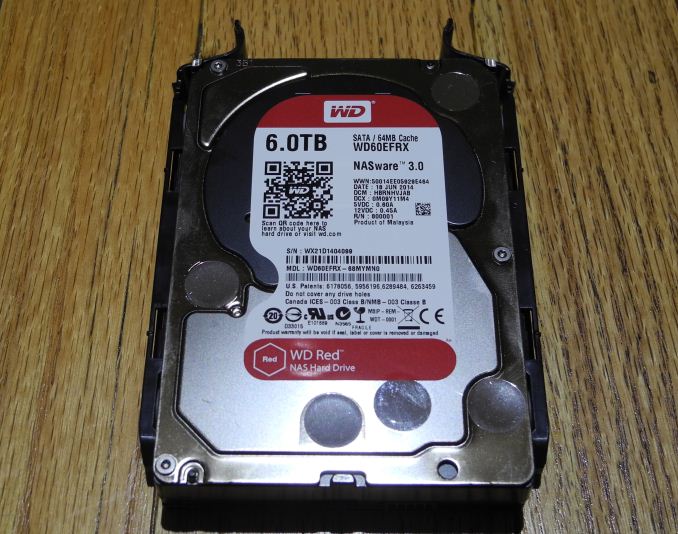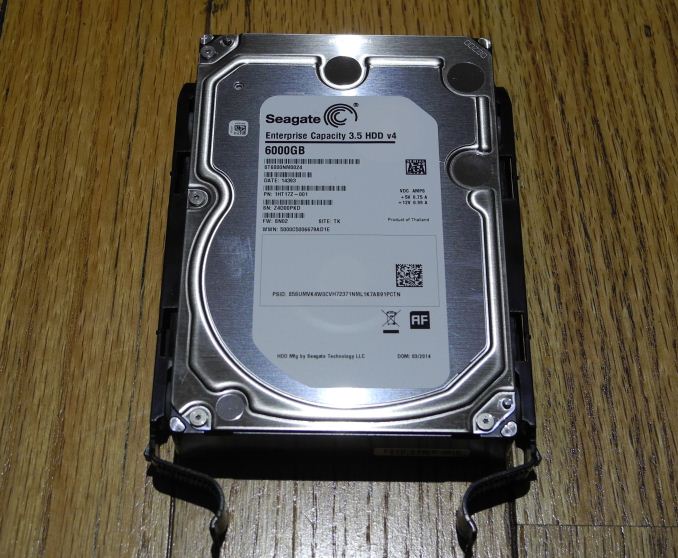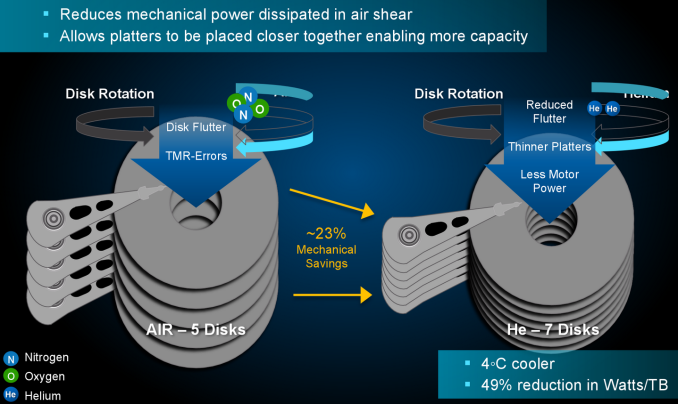6 TB NAS Drives: WD Red, Seagate Enterprise Capacity and HGST Ultrastar He6 Face-Off
by Ganesh T S on July 21, 2014 11:00 AM EST6 TB Face-Off: The Contenders
Prior to getting into the performance evaluation, we will take a look at the special aspects and compare the specifications of the three drives being considered today.
Western Digital Red 6 TB
The 6 TB Red's claim to fame is undoubtedly its areal density. While Seagate went in for a six-platter design for its 6 TB drives, Western Digital has managed to cram in 1.2 TB/platter and deliver a 6 TB drive with the traditional five platter design. The costs are also kept reasonable because of the use of traditional PMR (perpendicular magnetic recording) in these drives.
The 6 TB drive has a suggested retail price of $299, making it the cheapest of all the three drives that we are considering today.
Seagate Enterprise Capacity 3.5 HDD v4 6 TB
Seagate was the first to utilize PMR to deliver a 6 TB enterprise drive earlier this year. They achieved this through the use of a six platters (compared to the traditional five that most hard drives use at the maximum). A downside of using six platters was that the center screw locations on either side got shifted, rendering some drive caddies unable to hold them properly. However, we had no such issues when trying to use the QNAP rackmount's drive caddy with the Seagate drive.
Seagate claims best in class performance, and we will be verifying those claims in the course of this review. Pricing ranges from around $450 on Amazon (third party seller) to $560 on Newegg.
HGST Ultrastar He6 6 TB
The HGST Ultrastar He6 is undoubtedly the most technologically advanced drive that we are evaluating today. There are two main patented innovations behind the Ultrastar He6, HelioSeal and 7Stac. The former refers to placement of the platters in a hermetically sealed enclosure filled with helium instead of air. The latter refers to packaging of seven platters in the same 1" high form factor of traditional 3.5" drives.
With traditional designs, we have seen a maximum of six platters in a standard 3.5" drive. The additional platter is made possible in helium filled drives because the absence of air shear reduces flutter and allows for thinner platters. The motor power needed to achieve the same rotation speeds is also reduced, thereby lowering total power dissipation. The hermetically sealed nature of the drives also allows for immersive cooling solutions (placement of the drives in a non-conducting liquid). This is something not possible in traditional hard drives due to the presence of a breather port.
The TCO (total cost of ownership) is bound to be much lower for the Ultrastar He6 compared to other 6 TB drives when large scale datacenter applications are considered (due to lower power consumption, cooling costs etc.). The main issue, from the perspective of the SOHOs / home consumers, is the absence of a tier-one e-tailer carrying these drives. We do see third party sellers on Amazon supplying these drives for around $470.
Specifications
The various characteristics / paper specifications of the drives under consideration are available in the table below.
| 6 TB NAS Hard Drive Face-Off Contenders | |||
| WD Red | Seagate Enterprice Capacity 3.5" HDD v4 | HGST Ultrastar He6 | |
| Model Number | WD60EFRX | ST6000NM0024 | HUS726060ALA640 |
| Interface | SATA 6 Gbps | SATA 6 Gbps | SATA 6 Gbps |
| Advanced Format (AF) | Yes | Yes | No (512n) |
| Rotational Speed | IntelliPower (5400 rpm) | 7200 rpm | 7200 rpm |
| Cache | 64 MB | 128 MB | 64 MB |
| Rated Load / Unload Cycles | 300K | 600K | 600K |
| Non-Recoverable Read Errors / Bits Read | 1 per 10E14 | 1 per 10E15 | 1 per 10E15 |
| MTBF | 1M | 1.4 M | 2M |
| Rated Workload | ~120 - 150 TB/yr | < 550 TB/yr | < 550 TB/yr |
| Operating Temperature Range | 0 - 70 C | 5 - 60 C | 5 - 60 C |
| Physical Dimensions | 101.85 mm x 147 mm x 26.1 mm. / 680 grams | 101.85 mm x 147 mm x 26.1 mm / 780 grams | 101.6 mm x 147 mm x 26.1 mm / 640 grams |
| Warranty | 3 years | 5 years | 5 years |
The interesting aspects are highlighted above. Most of these are related to the non-enterprise nature of the WD Red. However, two aspects that stand out are the multi-segmented 128 MB cache in the Seagate drive and the HGST He6 drive's lower weight despite having more platters than the other two drives.













83 Comments
View All Comments
ganeshts - Tuesday, July 22, 2014 - link
I have seen graphs in preparation where some set of values are just dwarfed by the higher values from other result sets. What you see is basically a set of clustered points at the base (very close to the X axis), while there is a nicer graph with clearly spaced out values for the other result set in the middle of the graph. Trust me, I have done this and it doesn't look nice or present meaningful information to the readers.Fjodor2000 - Tuesday, July 22, 2014 - link
Are there any measurements and comparison of the noise levels for these new WD HDDs?Particularly for the WD Red 5 and 6 TB HDDs this would be interesting to know, and how they compare to the 4 platter WD Red 4 TB HDD.
stevenrix - Tuesday, July 22, 2014 - link
Any kind of hard-drive will fail sooner or later, but the quality of hard-drives has been horrible for the last 5 years or maybe more, which is unfortunately expected since bigger hard-drives increase MTBF. The professional drives seem to fail faster than consumer drives from what I've seen: a 1 tb SAS drive 3.5 inch 15K speed can fail just about 2 months after purchasing it, because the platters spin faster and they are no other additional technical enhancements on these drives compared to consumer drives.Out of probably 200 drives I've used over the last 2 decades, only one never failed and it is a WD 73 Gb in EIDE. After seeing so many failures, I decided to use RAID levels and backup my data on backup tapes.
There is also one important point: the replaced drives in the US is refurbished most of the time, while that's not the case in Europe, unless this has changed. Once you get a replacement, you can be sure that the drives will fail in less than 1 year, so those companies are defeating the purpose, replacing a drive by an old hard-drive that has been refurbished to meet satisfactory criterias, that is not good customer service without mentioning those monopolistic companies. A little bit more competition should be good for us consumers.
The only company so far I've been satisfied is with HGST.
jabber - Wednesday, July 23, 2014 - link
I live in Europe. Had a WD 75GB Raptor fail on me after a couple of years. The replacement was marked as 'Recertified'.That replacement is still going nearly 7 years later as one of my stunt drives. You know the one or two drives you have laying around that get tossed into all sorts of projects. Just keeps on trucking.
Jorsher - Thursday, July 24, 2014 - link
A lot of people seem to assume that new is better than "refurbished."What they don't realize is that refurbished products tend to go through a much more thorough testing process than brand new products. This is just based on a couple consumer electronics companies I've worked at, with the largest being LG. New products go through a relatively quick test, and in many cases they only test a few out of each batch. Products that are sent back due to warranty are first put through a thorough test to determine what problems it has, then it's decided if it's worth repairing or not, then it's repaired, then it's put through another test -- for every one.
Since those experiences, I now buy factory-refurbished when possible.
hwnmafia02 - Friday, July 25, 2014 - link
Man those companies provided you with such wonderful hardware and you can't even include the logos for each in the thank you section? Come on, now...Elmeransa - Saturday, July 26, 2014 - link
Running 8*3TB WD Red since 2 years back, no issues at all in raid5Haravikk - Monday, July 28, 2014 - link
One thing that wasn't mentioned was noise; while there were several reasons for my choosing WD Reds for my Synology NAS (a DS212j with two 3tb disks simply concatenated for capacity since it's already a redundant backup). My main decision factors were that the WD Reds were a reasonable price (not too far above greens), but are also exceptionally quiet; except for when they're initially spinning up or spinning down I can't even hear them over the sound of the NAS' fan, and the fan is barely audible to begin with. Meanwhile I've known enterprise drives that are very noisy, as well as various desktop disks that sound like someone pouring gravel (during normal operation).swansearecovery - Monday, July 28, 2014 - link
This post includes a great article on hard drives, truly brilliant. After reading the information given I have no second thought on that you people are also very good experts in handling the cases of Data Recovery from Hard Drive as well.http://www.swanseadatarecovery.co.uk/hard-drive-re...
intiims - Tuesday, December 30, 2014 - link
Great topic with a lot of usefull information,If You want To Read More About External Hard Drives just visit
http://www.hddmag.com/